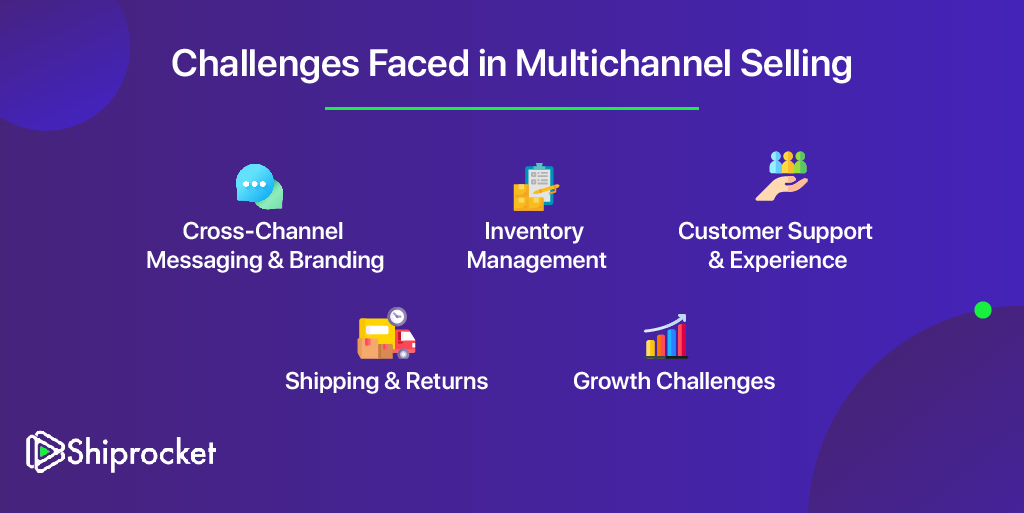5 Challenges of Multichannel Selling Faced By Retailers
Every ecommerce business owner wants to see their business grow and profits increase. Still, no one likes experiencing the growing pains that so often go hand-in-hand with scaling operations.
In ecommerce, investing in multi-channel can help you quickly take your business to the next level, but it can also come with several challenges you may or may not be aware of.

To succeed in multi-channel, you have to know how you’re going to address these challenges when they appear in front of you. You have to put a clear strategy in place before you necessarily need it.
Here are 5 of the most common challenges you might face as you work to spin up or scale multi-channel for your eCommerce business, and tips for overcoming those challenges:
Challenges Faced in Multichannel Selling

Cross-Channel Messaging & Branding
One of the biggest marketing challenges most ecommerce business owners face when it comes to multi-channel is keeping branding and messaging consistent across different channels. When you’re only selling your products on one channel, it’s much easier to control and keep track of the messages and branding you’re using to compel people to buy. But when you start investing in multi-channel, you’re forced to manage to message and branding consistent across several channels that all have different requirements, nuances, and best practices.
When you’re presenting your products to new audiences on new channels, you have to ensure that you’re creating the same first impression people are getting when visiting your website and buying products through your online store.
If you decide to test new product photos, graphics, or new key messaging to promote products and drive more sales on your website and find out those photos and messaging are more effective in boosting conversions than what you’ve used in the past. You need to make sure you’re updating your other channels too. Otherwise, you risk missing out on sales.
The critical thing to remember when it comes to adding more channels and marketplaces into your selling strategy is this: you only have one opportunity to make the right first impression. To be successful, keep messaging, branding, and consistency at the top of your mind when creating and updating product listing and brand pages for each channel.
Inventory Management
Another big challenge that most ecommerce business owners face when selling products on more channels is keeping up with inventory.
Overstocking & Overselling
When you’re investing in multichannel, it can sometimes be challenging to manage supply-demand or estimate how much product you’ll need to have on hand in a given month. Keeping too much inventory on hand can be expensive, but not having enough can prevent you from growing and serving new customers.
Lack of Visibility Across Multiple Channels & Multiple Warehouses
Without multi-channel software, it’s not always easy to keep track of the sales and orders from each channel. How those sales and orders are impacting the inventory, you have on hand. In addition, it’s equally as challenging to keep track of orders, merchandise, and relationships across all the warehouses, partners, and manufacturers you need to support all the channels you’re now selling products on.
To succeed with multi-channel, you need to track, understand, and leverage data relating to your inventory and customers. You have to know how inventory is fluctuating over time, how demand is changing over time, what demand will look like in the future, when to reorder products, when to scale back on products, and where breakdowns in your processes are happening.
Customer Support & Experience
When you’re only selling products through your website and store, creating the right customer experience is relatively easy to manage. But supporting and nurturing relationships with customers can quickly become a lot more challenging when you start selling on places like Amazon, eBay, Etsy, Facebook, Alibaba, and other online marketplaces.
To succeed in ecommerce, you have to serve your customers above all else. That means knowing what their pain points are, providing them with value, selling them high-quality products, offering world-class support, and creating delightful unmatched experiences for them.
If your customers are happy, your business will grow. It’s as simple as that.
Shipping & Returns
Shipping is another area that ecommerce business owners struggle with when they start selling products on more channels and marketplaces. Again, the big problem lies in the fact that when you are small and you’re only taking and fulfilling orders through your own website and store, shopping is a lot easier to manage. When you start adding more channels into the mix, you have to be ready to scale, otherwise, you risk. Otherwise, relationships with customers, ruining your brand reputation and losing out on future sales.
The takeaway here is don’t wait until you’re overwhelmed to figure out how to manage to ship for your business. Develop a strategy ahead of time, and start implementing it before you need it.
Growth Challenges
As you scale your ecommerce business and introduce your products on new channels and marketplaces, you should expect to encounter a handful of other growing pains along the way.
As you scale, you may have to change your product to ensure that you don’t lose out on product quality, be fiercely obsessed about it, and don’t allow your partners to cut any corners. Be clear about your expectations, and cut ties with anyone who can’t meet them.
Even a few seconds of slow page speed on your website can have a significant impact on sales. To ensure that your website can handle sudden increases in traffic and activity, work with your web developer, contact your hosting provider, and leverage tools like PageSpeed Insights from Google.
Final Words
To be successful with multi-channel growth, the key is to try to think about and plan for all the challenges you might face as you scale your business and operations. If you can be proactive about putting strategies in place, you’re much more likely to build a sustainable, profitable business in the months and years ahead.






Nice